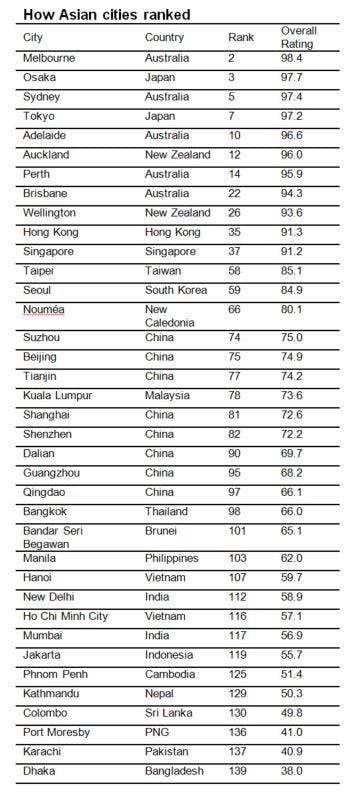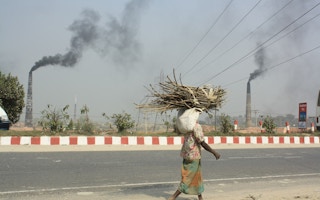South Asian cities have fallen lower in a ranking of the world’s most liveable cities due to the deteriorating quality of air.
To continue reading, subscribe to Eco‑Business.
There's something for everyone. We offer a range of subscription plans.
- Access our stories and receive our Insights Weekly newsletter with the free EB Member plan.
- Unlock unlimited access to our content and archive with EB Circle.
- Publish your content with EB Premium.
Nepal capital Kathmandu fell two positions to 129th place while Dhaka dropped two places to 139th spot in this year’s Global Liveability Ranking by The Economist Intelligence Unit (EIU), which assessed living conditions in 140 cities.
Air pollution and stability were major factors pulling South Asian cities down the ranking, said Roxana Slavcheva, EIU’s head of city practices who was the editor of the survey. “Dhaka in Bangladesh—which has been the lowest ranked city in Asia for over a decade—saw a further decline in its liveability rating owing to increasing air pollution, originating primarily from the brick kilns that line the outskirts of the city.”
Nepal and Bangladesh have among the worst air quality in the world, causing respiratory problems among residents. India has similarly been battling the “national crisis” of air pollution for years and rolled out a National Clean Air Programme in May. Indian cities Mumbai and New Delhi ranked 117 and 112.
Security issues were a major reason for the poor scores for Pakistan capital Karachi (137) and Port Moresby (138) in Papua New Guinea, the two other Asian cities besides Dhaka in the bottom 10.
Slavcheva remarked that Sri Lanka was also scored lower for stability. “Sri Lanka’s declaration of a nation-wide state of emergency in March, following clashes between Sinhalese Buddhist and Tamil Muslim communities, impacted Colombo’s civil unrest score, which has also in turn caused a decline in the overall stability rating for the city.” Capital Colombo was ranked 130.
Liveability leaders
On the other end of the liveability scale is Vienna. The Austrian capital was named the world’s most liveable city for 2018, breaking Melbourne’s seven-year streak at the top of the ranking.

Cities in the Asia Pacific ranked according to how liveable they are. Image: The Economist Intelligence Unit
To determine how liveable each city is, EIU assigned scores for over 30 factors in five categories: stability, healthcare, culture and environment, education, and infrastructure for a maximum score of 100 per cent.
The world is more liveable than before, the research found, with an increase in global average liveability score from 54.8 to 75.7 per cent in the last five years. Hanoi is one of the most improved cities, reflecting its booming economy and political stability. The quality of the capital’s theatre productions, private education and road network has also improved, Slavcheva told Eco-Business.
Although Melbourne was dethroned this year, the Asia Pacific region as a whole did well, she noted. “With a global top 10 containing three Australian cities and two Japanese ones, Australasia clearly dominates the top performers.”
Sydney took fifth place in the ranking, with Adelaide in 10th. Japanese metropolises Osaka and Tokyo rose to third and seventh positions respectively because of a “consistent decline in crime rates”, which boosted scores for infrastructure and stability.
Hong Kong’s scores in stability have bounced back after the end of the Umbrella Revolution civil uprising to take 35th spot, trumping regional rival Singapore, which placed 37th, by a marginal 0.1 per cent.
“Singapore’s ranking fell by two spots this year, but this was the result of an improvement in the scores of other cities,” said Slavcheva. The city-state’s score had actually risen on the back of increased spend on public healthcare and plans to build new hospitals and polyclinics.
Capital of neighbouring Malaysia, Kuala Lumpur, fell eight places to 78th because of “increasing media censorship and the politicisation of Islam before the 2018 general election”, noted Slavcheva.
How the Pakatan Harapan administration will impact conditions in the city is yet to be seen, but the new government has “a chance to address grievances over corruption as well as undertake human rights reforms,” Slavcheva said.
Elsewhere in Southeast Asia, Bangkok ranked 98th while Manila was 103rd.
Cities in the world’s most populous country, China, occupied the middle band of the ranking with little change from the year before. Suzhou, famed for its canals, bridges and classical gardens, was the nation’s most liveable city in 74th place, followed by capital Beijing in 75th and cosmopolitan Shanghai in 81st.
Slavcheva cautioned that the region’s progress was not uniform. “At the other end of the scale, three of the cities posing the highest number of challenges to daily life are also located in the region, so the picture is a lot more nuanced,” she elaborated.

















